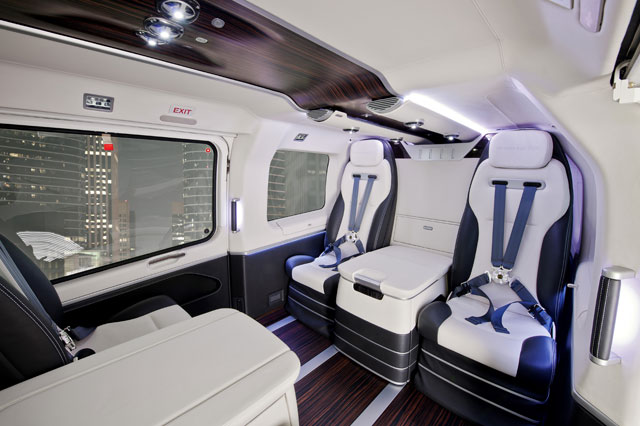Mecaer Aviation Group is a classic tale of how the lowliest components shop can haul itself up the aerospace supply chain if it has enterprising owners who are prepared to invest in engineering and design capabilities, think globally, and have a knack for spotting gaps in the market.
At the start of the 1990s, MAG's factory in Borgomanero - a town in the industrial heartland that surrounds Milan - was one of a cluster of Agusta-run workshops across the region, building-to-print landing gear and other components for the Italian rotorcraft champion. Divested in 1994, its new proprietors inherited a business with a turnover of just $3 million, almost all of which came from Agusta.
Two decades on, MAG is still very much in the helicopter market, but its activities include cabin as well as landing gear manufacturing, and design. More than 500 people work across nine locations in Europe and North America. And - although AgustaWestland still accounts for 70% of its revenue - a growing share comes from competitors such as Bell and Eurocopter. Sales this year will be around $150 million. The investors who bought the business from Agusta had a very clear strategy, says Armando Sassoli, general manager of business development.
 |
|---|
| Landing gear has always been a speciality of the previously Agusta-run company Mecaer |
"They asked themselves: 'What do we know what to do? Is there a space that's less crowded with fewer competitors?'" he says. The answer was developing an expertise in "landing gear and cabin comfort solutions".
The rationale was simple. While there are bigger, more influential players in landing gear - including Goodrich, Liebherr and Messier-Bugatti-Dowty - MAG specialises in rotorcraft and general aviation. "There aren't many that operate as an integrator, that can go to an OEM [original equipment manufacturer] and say: 'we are your landing systems solution'," says Sassoli.
The thinking was the same on cabin outfitting. MAG - which had a full-size interior mock-up of AgustaWestland's in-development AW169 on show at the recent National Business Aviation Association convention in Orlando - diversified into completions after acquiring another former AgustaWestland plant in the early 2000s. "There are a lot of suppliers, but the market is fragmented. There are few who can put it all together for the OEM," he says.
Although MAG acquired another small company in Montreal in 2002, most of its growth has been organic. Two years ago, it opened a site in Fort Worth - where Sassoli is based - to concentrate on its activities with Bell. Earlier this year, it announced that it had won the deal to design and supply the landing gear for the new Bell 525 Relentless, supplementing an existing 429 contract.
 |
|---|
| Cabin comfort solutions were deemed an attractive niche by Mecaer's investors Mecaer |
It is also opening an office in Russia to support AgustaWestland's new joint venture with Russian Helicopters and obtain other work in the country. It also has overseas completion in-plants at AgustaWestland factories in Philadelphia and Yeovil in the UK, where AgustaWestland has plans to develop its civil business.
Its non-AgustaWestland work should grow as a proportion of overall turnover, says Sassoli. Outside helicopters, MAG has secured landing gear contracts with Eclipse, Diamond and Turkish Aerospace Industries on its Hurkus trainer. It also carries out build-to-print work for Goodrich and Gulfstream. "Ten years ago, 95% of our sales came from Agusta," he says. "We are winning new customers, but there is a lag before that business will be reflected in our sales. We want to diversify further."
Interiors will play a big part in that growth, says Sassoli. That business - which includes assembly and maintenance, repair and overhaul as well as a design studio - represents half of MAG's turnover, and has until now been heavily dependent on AgustaWestland. "We complete almost all their commercial helicopters," he says. "The relationship is absolutely fundamental to us." But Sassoli feels there is potential from elsewhere in the industry.
MAG has invested almost $90 million in design and development over the years with the aim of creating proprietary products, and 15% of its workforce is made up of design engineers. The setting up of the design studio in 2011 has been a key part of that strategy. "We wanted to create our own brand in this area," says Sassoli.
One of these proprietary products is what MAG calls its Silens cabin system, a detachable, composite capsule installed in more than 100 AW139s, for which it owns the supplementary type certificate. MAG claims that soundproofing reduces the ambient sound from 76dB on a "standard" cabin to 68dB. "For VIPs this is very important," says chief executive Claudio Brun. "In practical terms, it means you can speak to colleagues without a headset."
However, while design engineering is the more glamorous and fastest growing part of the company, MAG plans to retain its milling machines and production lines - although it has begun to establish its own global supply chain, sourcing materials and products from far beyond Italy - including China, Costa Rica and South Korea. "Manufacturing is still important for us," says Sassoli. "We intend to remain a 360-degree company. Having that vertical control is key to our success."
Source: Flight International























